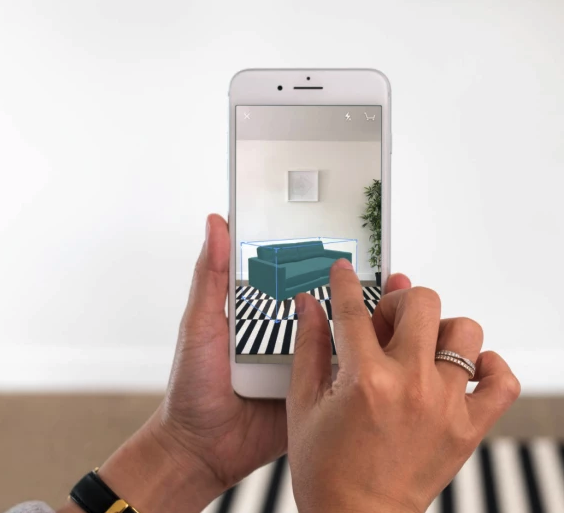
In the exciting journey of blending the digital and material in the commerce world, we have seen the emergence of great technologies including Virtual Reality, Augmented Reality, Internet of Things, 3D Printing, etc. As they evolve and become democratised, the barrier to entry in using these technologies keeps getting lower; 3D and Augmented Reality (AR) are prime examples: any retailer can now implement these technologies at a relatively low investment cost.
Visual representation has always been one key challenge in e-commerce: there’s a limit to which a shopper can inspect an item but also visualise it into a physical setting such as a room, next to other objects or on your own body. Interactive 3D images address the visual representation challenge by allowing users to see an object dynamically from any angle, and subsequently, AR solves the visualisation of an object in a material environment through a phone or tablet camera. With 3D and AR, shoppers get a better sense of the size, scale, detail of a product and the look of it in a real environment.
An increasing number of leading retailers such as Ikea, Made, Warby Parker, Bang & Olufsen, Sephora, Amazon and eBay are now leveraging 3D & AR technologies. Tech giants also now support the development of new AR applications with the release of the ARKit from Apple and the ARCore from Google. Ad Platforms are experimenting as well, with Facebook actively testing a new AR ad format with Michael Kors.
Data is backing the return on investment of these technologies:
- TSUM, one of the largest luxury goods department stores in Eastern Europe, increased its conversion rate by almost 40 percent for products in categories which are 3D digitised.
- Interior design platform, Houzz, reported consumers exposed to AR products were 11 times more likely to purchase and spent 2.7 times more time in the Houzz app.
- The Harvard Business Review stated that augmented reality spending will reach $60 billion by 2020.
So, how can online retailers leverage 3D and AR today?
Step One: 3D-Digitise Your Retail Inventory
The process consists of re-creating a digital version of each item, using original photos and dimensions to create a digital matching model. Each model will most likely be built in one of the popular 3D file formats: usdz, gtlf, gld. Online retailers won’t often have the necessary skill set in-house to get this done, and that’s where 3D and AR technology providers, as well as independent 3D design freelancers, can help in this process. Alternative solutions also exist where an item is photographed on a turntable, but user interaction with the 3D model is then limited.
Step Two: Embed a 3D ‘Viewer’ on the Front-End of the Online Store
This viewer reads the 3D file created for each item and displays it as an interactive image. Shoppers can then see and interact with it on any browser and device. Retailers can build their own 3D viewer or leverage viewers from existing technology providers such as Sayduck or Augment.
Step Three: Implement the AR Component, Leveraging the Existing 3D Files
Depending on the file format used, mobile and tablet users may have the ability to use AR without the need for an app. For example, a usdz file can be seen in AR using the Safari browser on iOS 12+ devices. Outside of native support, retailers have the option to build their own AR app like IKEA or Sephora did, using the Apple or Google AR kits, or leverage technology providers and their proprietary AR apps.
With the right support, these three steps are relatively easy to put in motion. A retailer doesn’t need to process its entire store catalogue initially: a ‘proof of concept’ can be done with just a few items with large traffic volume and high price point. The retailer can then monitor key metrics such as conversion rate and customer lifetime value for shoppers interacting with these items vs the rest of the catalogue and calculate the potential ROI if there is a positive uplift. In addition to direct ROI, as 3D and AR are not widely used across the retail landscape yet, early adopters can stand out from their competition by delivering a more interactive customer journey.
The same way mobile commerce has taken over online shopping, we can imagine a future where 3D images and AR-support replace fixed 2D images and become the e-commerce standard for product visualisation, delivering the immersive shopping experiences expected by consumers.
Never miss our best stories. Sign up for Power Retail’s free weekly newsletter and find our daily stories on Facebook, Twitter, LinkedIn, and Instagram.

